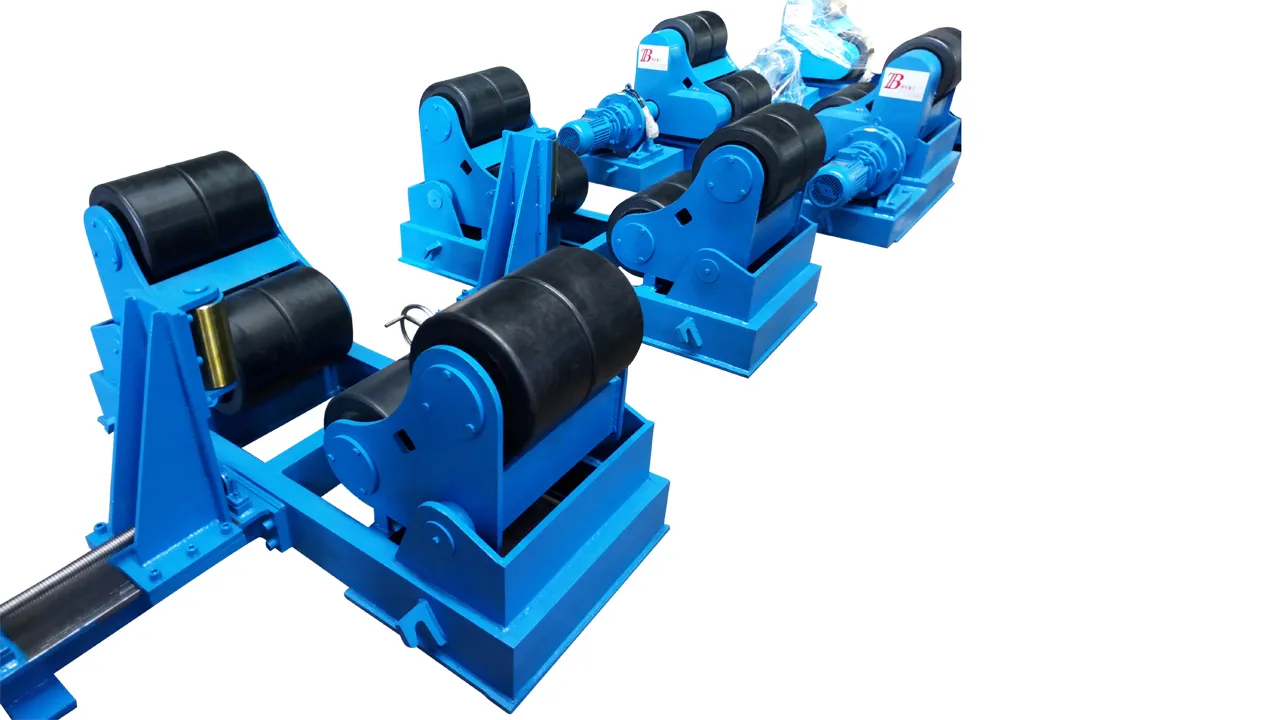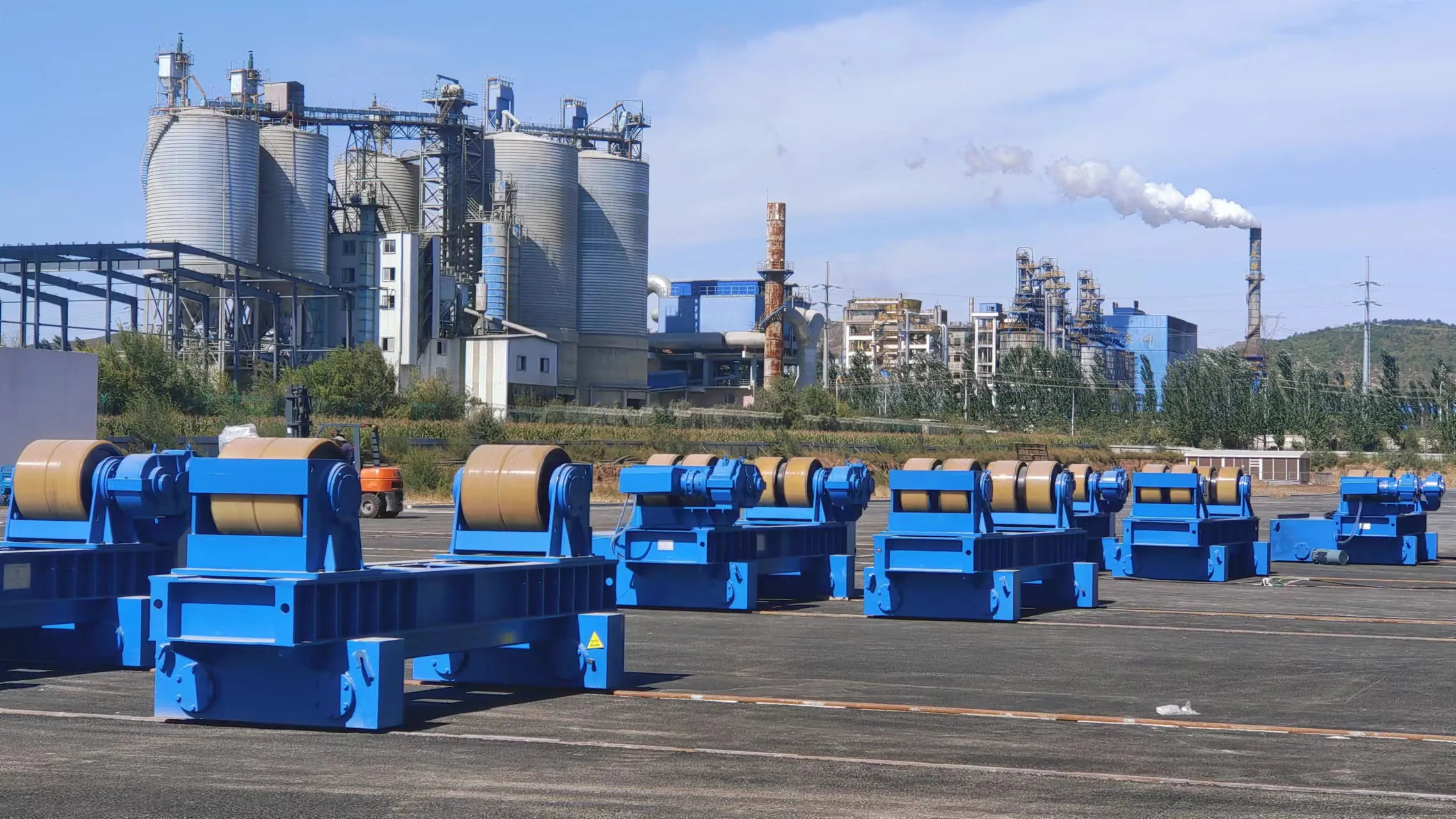Welding rotator is a commonly used welding auxiliary device, which is widely used in welding production process. Mainly rely on the friction between the weldment and the driving roller to drive the rotation of the cylindrical weldment, and combine with the welding manipulator, welding positioner, etc. to realize the automatic welding of the inner and outer circular seams, fillet welds and inner and outer longitudinal seams of the weldments . So today the editor will take you into the manufacturing structure of the welding rotator.

The axial movement of the weldment on the roller frame means that the weldment itself is in a spiral motion. If measures can be taken, the left-handedness of the weldment on the welding rotator can be changed to right-handed or right-handed to left-handed in time, until The weldment is no longer in spiral motion.
Currently, there are three actuators available for this task:
(1) Jack-up actuator
The side rollers of the driven roller frame can move up and down, so that the axis of the weldment is shifted, and at the same time, the axial component produced by the self-weight of the weldment is also changed. The advantage of this adjustment method is that the adjustment sensitivity is high, and the disadvantage is that the manufacturing cost is high and the volume is large.
(2) Offset actuator
The rollers on both sides of the driven roller frame can be offset in the same direction along its vertical centerline, so as to change the axial friction component between the rollers and the weldment. The advantage of this adjustment method is high sensitivity, but the disadvantage is that it wears too much on the roller.
(3) Translational actuator
The rollers on both sides of the driven roller frame can move horizontally perpendicular to the axis of the weldment at the same time, so as to achieve the purpose of adjusting the axis of the weldment and the angle between the axes of the rollers. This adjustment method has the advantages of good stability, low manufacturing cost, simple structure, and does not occupy additional installation space.
In order to achieve the smooth rotation of the weldment without speed regulation, two driving methods are generally used: DC speed regulation and AC frequency conversion speed regulation. Due to the defects of high failure rate and high cost of DC speed regulation, AC frequency conversion speed regulation was selected. With the development of electronic technology, AC frequency conversion speed regulation has been able to fully meet the needs of welding rotators of various tonnages.
In order to make the adjustment of the distance between the rollers of the welding rotator convenient and reliable, and the combination is convenient, it is recommended to adopt the design scheme of single drive of the driving wheel, that is, each driving wheel is driven by a single motor and a reduction mechanism. However, attention should be paid to solving the synchronization problem of the driving wheels here, and the structure of the motor and the reducer should be as consistent as possible and used after actual measurement. In terms of driving mode, it is recommended to use a set of driving sources, and each drive wheel motor is connected in parallel.
The purpose of detecting the axial movement of the weldment is to detect the movement displacement of the weldment in the axial direction. In principle, the detection method on the side of the weldment cylinder wall and the detection method on the weldment surface can be adopted. The detection method of the side of the cylinder wall can not be affected by the error of the weldment surface, but this detection method needs to remove the vertical rotation component of the cylinder wall, plus the influence of slipping, rough surface of the cylinder body, and dirt, so it is necessary to manufacture a reliable The sensor comes not easy. The detection method on the surface of the weldment is a common detection method at present. This detection is always inevitably affected by the unevenness of the weldment surface and its axis in the vertical direction, so it is required to process the tested surface of the weldment. However, for large weldments, the higher the precision required for this processing, the greater the difficulty and expense. It is important to be able to reduce the requirements for surface processing. For example, the process requires that the axial movement of the weldment is not greater than ±2mm, but the unevenness of the measured surface of the weldment is greater than ±2mm. It is one of the important indicators of whether the rolling roller frame is practical.

For a weldment, especially for a large weldment, it is difficult to know exactly the verticality and unevenness of the detection surface relative to its axis. It is sometimes unrealistic to rigidly stipulate that the surface processing error does not exceed a certain value. Under such conditions, how to achieve the purpose of anti-movement for different weldments, or even zero movement, is the key.
For control systems such as anti-channeling roller frames, in the case of many uncertain factors affecting the axial movement of weldments, fuzzy control can be used to achieve the control purpose. Fuzzy control is to use computer to simulate human's way of thinking and control according to human operation rules, that is, to use computer to realize human control experience. Fuzzy mathematics can be used to describe fuzzy concepts such as process variables and control action quantities and the relationship between them, and then use fuzzy logic reasoning to obtain the control quantity at that moment according to these fuzzy relationships and the detection value of the process variable at each moment. Fuzzification and control are in a dialectical relationship. Computers imitate human thinking to carry out fuzzy control, and the most important control experience of human brain is fuzzy control rules composed of fuzzy conditional sentences. Therefore, it is necessary to convert the input signal from quantity to fuzzy quantity. Fuzzification first converts the sampling value of the input signal to a point on the corresponding domain of discourse (range transformation), and then transforms it into a fuzzy subset on the domain of discourse. Contrary to fuzzification, the process of defuzzification is to transform the fuzzy control effect obtained in the reasoning process into the control quantity.
However, for the control system in which the error of the detection surface of the controlled weldment is greater than the precision of anti-channeling, it is obviously not enough to solve the problem only by fuzzy control theory in order to realize the purpose of anti-channeling of the weldment. Because the surface error of the weldment is greater than the anti-channeling accuracy requirement, whether the offset sent by the sensor is caused by the surface error of the weldment or the axial movement of the weldment, the computer only The signal is indistinguishable, and the error size and shape of different weldments are different.
Adaptive control has the ability to modify intrinsic parameters to adapt to the dynamic changes of the controlled object and disturbance. In adaptive systems, the algorithm we use is the "parameter pursuit algorithm". That is, the computer performs automatic tracking and preset action thresholds on the sent signals, and these parameters are not fixed during the control process. In layman's terms, it is to let the computer memorize the surface shape of the weldment first, and then distinguish the real amount of movement. In this way, the problem is simple, as long as the amount of movement is controlled and the surface error is ignored. Following this line of thought, after a period of adjustment, the "zero movement" of the weldment in its axial direction can be achieved. The length of the self-adaptive process depends on the surface error of the weldment. For a weldment with a surface error of 5mm, the amount of movement can be limited within ±2mm after about 15 minutes, and the weldment can be maintained after about 0.5h. "Zero movement".
After explaining so much about the manufacturing structure of the welding rotator, what we have to mention in use is the precautions for the installation of the welding rotator.

The welding rotator is a device that drives the cylindrical (or conical) weldment to rotate by means of the friction between the weldment and the driving roller. It is mainly used on series of large machines in heavy industry.
1. Before the equipment is installed, the foundation of the equipment must be prepared to ensure the normal maintenance period of the concrete and ensure that the installation position of the equipment is on the same level.
2. When installing the equipment, install and fix the equipment according to the installation requirements of general equipment. It can be fixed with expansion bolts (or fixed with a pressure plate).
3. After the equipment is installed, check whether each part of the equipment meets the assembly requirements, and ensure the normality of the electrical wiring of each part, check and clean the periphery of the equipment, and ensure that there are no obstacles that affect the normal operation of the equipment. Only after several tasks have been successfully completed should the device be powered on for operation.
Only one roller part of the adjustable roller frame is a driving roller part, and the other is a driven roller part. The driving device adopts frequency conversion speed regulation motor, and the roller parts are driven by the reducer, and the weldment is driven to rotate for welding. The adjustment of the distance between the roller parts in each roller frame is done manually by using positioning bolts according to the condition of the weldment. Therefore, the function of the adjustable roller frame circuit can be said to be the direct factor determining its driving device.
The welding rotator simplifies the welding process, improves the welding hygiene and safety conditions, and can greatly improve the quality of the weld, reduce labor intensity, and improve work rate, which plays an important role both for the operator and for the enterprise.
No information
What are the features of welding column boom
No. 1 Intersection of Chuangye Avenue and Weilai Avenue,
Yiyang County,Luoyang City, Henan Province, China
+86 400-0379-069
Copyright © 2023 An Automated Welding and Cutting Equipment Manufacturer Focusing on Welding Column Boom and Welding Rotator | All Rights Reserved Technical support: ShangXian